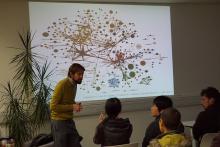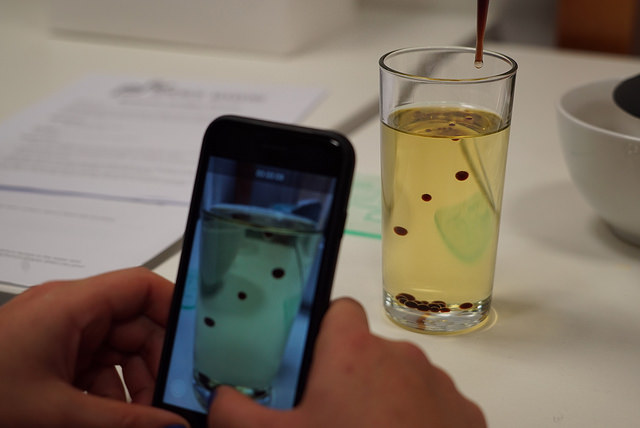Lab equipment and chemistry has made its way into the kitchen - with water baths, centrifuges, freeze dryers, 3D printers and more now involved in gastronomic creations. During the December 2017 Science Makers session, over 25 members of the SRI, Cambridge Makespace and interested members of the public heard about some of the techniques of 'molecular gastronomy' and tried them out!
Dr Sebastian Ahnert (Sainsbury Lab and Department of Physics) presented his work (see slides) on network analysis of chemical flavour compounds - do compatible flavours share chemical profiles? Sebastian argued that the rapidly growing body of publicly available data on food chemistry and food usage can be analysed using data mining and network analysis methods which could yield new insights into culinary practices and perhaps result in fields such as ‘computational gastronomy’ (Ahnert, 2013). He investigated cultural diversity in flavour by constructing a flavor network that captures the flavor compounds shared by culinary ingredients in large online recipe databases. The analysis indicated that Western cuisines show a tendency to use ingredient pairs that share many flavor compounds, while East Asian cuisines tend to avoid compound sharing ingredients. Given the increasing availability of information on food preparation (Ahn et al., 2011).

More recently, he is interested in new frontiers that are accessible through increasingly details analysis. For example, study of umami taste through a combination of chemical analysis and quantitative sensory evaluation, including analysis of culinary habits recorded by individuals on social media and studying the properties of flavor compounds. There is evidence that large-scale data analysis is already transforming our understanding of food perception and consumption, and that it is likely to fundamentally influence our food choices and habits in the future.

Robert Curtis (Dovetailed) then spoke about 3D-printing food with nufood. Dovetailed is an interaction design company run by Vaiva Kalnikaite whose team includes industrial designers, engineers and food scientists.The beautifully designed 'kitchen robot' 3D printer can create spheres in a variety of flavours (theoretically any liquidised food) and build them up into complex shapes programmed via a smartphone app. So far, the team have run several pop-up restaurant sessions and exhibited in various locations following a successful Kickstarter. They are currently exploring making the device available to consumers and Robert gave some fantastic examples of Kir Royale cubes, printed pasta ravioli and even honey.
See full news item >>
View more photos from the event >>

Speaker Slides
- Dr Sebastian Ahnert [PDF]
Instructions for Participants
- Nutella Powder [Doc | PDF]
- Balsamic vinegar pearls [Doc | PDF]
- Melty cheese with sodium citrate [Doc | PDF]
- Spherical Yogurt Recipe (Reverse Spherification) [Doc | PDF]
- Spherical Mango Ravioli (Basic Spherification) [Doc | PDF]
For Facilitators
References
O. G. Mouritsen, R. Edwards-Stuart, Y.-Y. Ahn, S. E. Ahnert. Data-driven Methods for the Study of Food Perception, Preparation, Consumption, and Culture. Frontiers in ICT 4, 15 (2017)
S. E. Ahnert. Network analysis and data mining in food science: the emergence of computational gastronomy. Flavour 2:4 (2013)
Y. Y. Ahn, S. E. Ahnert, J. P. Bagrow, A.-L. Barabasi. Flavor network and the principles of food pairing. Scientific Reports 1:196 (2011)

